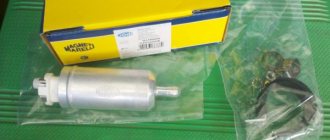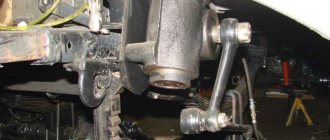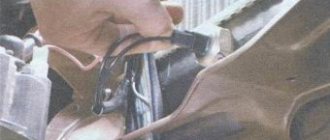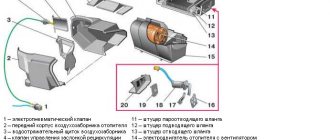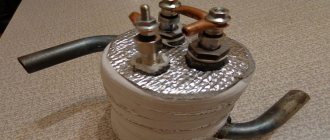How to replace antifreeze on a VAZ 2107?
The engine cooling system is an important part of every car, through which the normal operation of the engine is ensured. A significant part of the cooling system is devoted to refrigerant or coolant, which can be presented in the form of antifreeze (in most cases), antifreeze or distilled water. During the operation of any car, including the VAZ 2107, it is important to promptly replace the coolant, which will improve the efficiency of the cooling system. In this issue, we will look in more detail at how to correctly replace antifreeze on a VAZ 2107, what is required for this and where to start.
Replacing the coolant: why is this event being carried out?
The cooling system of modern cars is presented in the form of a liquid-type system, which means heat is removed from the car engine through liquid. The coolant circulates through the system, removing heat from the engine and cooling in the radiator. The pump or water pump redirects the cooled portion of the liquid to the engine to cool the latter again. The heat exchange process occurs continuously while the car engine is running and the pump is rotating.
As the coolant is constantly exposed to different temperatures, it loses its properties over time. When antifreeze loses its properties, its boiling point decreases and approaches the boiling point of ordinary water. Most often this happens after a mileage not exceeding 60 thousand km. It is at this mileage that it is recommended to completely replace the antifreeze in order to avoid unforeseen and undesirable consequences. Before we begin the replacement, let’s find out how to properly drain antifreeze from a VAZ 2107.
How to properly drain used fluid
To drain antifreeze from a VAZ 2107 car, simply opening the tap is not enough, through which all the liquid will flow out of the system. Both antifreeze and antifreeze are toxic substances, so when working with them you should follow safety rules. Before draining, it is necessary to prepare a container into which the waste will be drained. The volume of such a container should not be less than 10 liters. The best option for such purposes is a trough or basin.
It is easy to carry out the work without an inspection hole, so it is recommended to install the car on the handbrake, and then place a trough or other container under the engine. We begin the process of draining the liquid, for which the following steps are performed:
- The first step is to open the hood, then unscrew the cap from the expansion tank. This is necessary in order to reduce the pressure in the system, thereby speeding up the process of draining the waste. It is also recommended to unscrew the cap on the radiator.
- It is necessary to open the heater tap from inside (move the lever to the “warm” position) in order for the coolant to drain from the heater radiator.
- The next step requires unscrewing the plug bolt, which is located at the bottom of the cylinder block.
- Now you can start unscrewing the drain plug. located on the radiator. After unscrewing it, drain all the used fluid into a container, which may take up to 10 minutes.
- At the next stage, you need to loosen the fastening of the expansion tank, and then lift the latter up to drain the remaining liquid from it. How much antifreeze will be in the system depends on how often the car owner added it there.
The capacity of the cooling system of VAZ-2107 cars is just over 8.5 liters, so you need to wait until the last drop flows out. While the antifreeze is draining, you can prepare a new canister that will be poured into the system.
It is important to know! It is strictly forbidden to start the car when there is no antifreeze in the system.
Features of filling coolant
During the process of replacing the coolant, you can perform the procedure of changing the sealant or clamps on the pipes if leaks were noticed earlier. To do this, it is necessary to remove the pipes, check their integrity, remove any old sealant, then apply a new one and put it back in place. If the pipes have obvious defects, then it is better to replace them immediately, so that after a while the new antifreeze does not end up under the car.
Before adding a new type of antifreeze, you should tighten the drain bolt on the cylinder block, as well as the lower plug on the radiator. Don't forget to complete these steps before you begin the pouring process. We recommend doing the filling as follows:
- Before filling, unscrew the sensor located between the spark plugs of the 3rd and 4th cylinders, slightly higher, from the cylinder block. This will prevent the formation of an air lock in the car's cooling system;
- now antifreeze is poured into the VAZ 2107 through the hole in the radiator until it flows out of the hole from the sensor in the block in an amount of about 5 liters;
- screw the sensor into place and continue pouring;
- It is necessary to pour until the radiator is completely filled. You can additionally move the pipes to release air from them;
- After filling the radiator, you need to close its cap and add coolant into the expansion tank to the range from “MIN” to “MAX”.
It is important to know! Replace the coolant on your car only when the engine is cool. Antifreeze is very toxic, so inhaling its vapors can affect your well-being.
On VAZ 2107 cars, the injector and carburetor differences in the cooling system are insignificant. The only difference is that the temperature control system sensor is installed on the injector and the throttle body is heated. The carburetor engine of the "seven" has a more simplified cooling system, but they work on the same principle. There is no difference in the coolant capacity of the cooling systems of carburetor and injection engines. Above is a video about how antifreeze is replaced on a “seven”.
Communities › Auto club VAZ and Lada Classic. › Blog › Flushing and replacing antifreeze VAZ-2107
It's time to replace the coolant in the engine with a new one; the car has been running on it for more than 5 years.
Although, according to the standard, it should be changed every 2 years or 60 thousand km. Thus, long-term operation of a car on old fluid is fraught with rapid wear of the pump, corrosion of internal engine parts, souring of the heater tap, leaking pipes, deterioration of heat transfer, etc. Initially, blue antifreeze class G11 was poured into the car and over time the liquid changed color from blue to blue-green, became cloudy, and a coating formed at the bottom of the expansion tank.
Therefore, this time we will fill in antifreeze of a more advanced class G12+, red in color, with a specified service life of up to 5 years.
Let's pre-flush the system with a special flush.
First, you need to drain the old fluid from the radiator and engine block; they have a faucet and a drain plug, respectively.
We use a suitable hose for convenience - the liquid is toxic. In our case, a pre-heater is installed on the engine instead of a plug, so we’ll simply remove one of its pipes.
We open the caps of the radiator, tank and heater tap for better release of liquid. About 8 liters of antifreeze should drain (cooling system capacity 8.6 liters).
Now we will flush the system with water from a hose under pressure, after closing the radiator tap until clear liquid begins to come out of the block.
Then we close the drain holes, fill in the flush and fill the system with water.
To better remove air, remove one of the throttle heating pipes until liquid flows out, and put it back on.
We start the engine and, according to the instructions, let it run for 10-15 minutes, at the same time adding water and pressing the upper pipe until the air stops escaping.
This time is just enough to warm up the engine to 100 °C by the time the cooling fan turns on.
At the same time, turn on the interior heater fan at full power and open the tap to clean the radiator.
After warming up, turn off the engine, let it cool a little and drain the flushing fluid.
No large flakes or inclusions were found. Rinse the engine again with running water and let it drain thoroughly. While it is draining, you can replace worn out and stiffened pipes (it is better to replace them as a set).
In our case, this is a pair of pipes going to the thermostat; one cracked; the other, due to loss of elasticity, was leaking liquid that dripped onto the generator.
Now you can start filling in new antifreeze; first close all drain holes.
Approximately 8.6 liters of antifreeze should enter the system. To better fill the system, we again remove the throttle heating hose, start the engine and, as air leaves the radiator, top it up, pushing through the upper pipe.
When the air stops escaping, fill the liquid up the neck and close the radiator cap. Fill the expansion tank above the min mark.
Warm up the engine to operating temperature, keeping an eye on the pipes. Don’t forget to turn on the stove; warm air should blow from it, then hot air as it warms up.
When the fan operates, turn off the engine, check the pipes for leaks, and tighten them if necessary. In this case, the level in the tank should rise slightly and drop as it cools. Also, over the next few days, we check whether there is any liquid dripping anywhere, since when washing, the old protective layer from additives is removed, and a new one has not yet formed. A short video:
Good luck on the roads!
Beginning car owners of the domestic automobile industry, learning the basics of car ownership, often ask various questions about servicing and repairing VAZs. One of the most frequently asked questions regarding the cooling system: which is better - Antifreeze or antifreeze for VAZ?
The question is quite interesting and is asked often, especially from owners who purchased a car, but were unable to get a clear answer from the former owner as to what was poured into the cooling system.
And before the winter period, when car preparation is required, this question comes up and makes you think. Let's try to figure it out.
Stages of replacing coolant VAZ 2107
On most classic Lada cars, drainage is provided from the radiator, as well as the engine. But before adding new antifreeze, it is recommended to flush the cooling system to prevent impurities from getting into the new liquid.
During the production of the VAZ 2107, a large number of modifications were produced, which were equipped with various engines. But at the moment the most popular are gasoline versions in carburetor and injector versions.
Before you start replacing the coolant, to avoid getting burned, you need to wait until the engine has completely cooled down. You should also avoid getting antifreeze or antifreeze on the skin, eyes or digestive organs, since the chemical composition of the liquids is toxic.
Coolant drain
Before starting the draining procedure, you should prepare tools, containers for used antifreeze, as well as new liquids for subsequent refilling. If protection is installed under the engine, it can also be removed for convenience.
Next, we perform the procedure for draining the liquid from the VAZ 2107:
- Turn the temperature regulator in the cabin to the maximum position to the right (Fig. 1).
Flushing the cooling system
If there are deposits in the drained liquid or there is a transition from antifreeze to antifreeze, the system should be flushed. To do this you need to do the following:
- Flush the system with plain water through the expansion tank of the VAZ 2107. The plugs must be open;
- tighten the drain plug and bolt;
- fill the system with a flushing agent (you can use Liqui Moly Kuhlerreiniger or Lavr cooling system flush) with distilled water (6-7 liters);
- start the engine. Warm up to 90 degrees;
- leave it idling for 5-10 minutes, depending on the contamination of the system;
- muffle it. Allow the engine to cool to approximately 60 degrees;
- drain the flush using the same steps as removing the old fluid;
- tighten both plugs;
- fill with distilled water to rinse the cooling system;
- start the car and warm up to 90 degrees;
- turn off and let cool to 60 degrees, drain;
- repeat steps 8, 9, 10 and 11 if necessary.
Coolant quantity VAZ 2107
So, how much antifreeze or other coolant should be poured into the VAZ 2107? According to the instructions, you need to use 9.85 liters, which means that you need to purchase 10 liters of coolant. However, what exactly should you choose – antifreeze or antifreeze? There is simply no clear answer to this question. Many drivers prefer antifreeze exclusively. It is sold ready for use or in concentrated form. In one of the articles on the Avtopub website we will definitely look at the advantages of this choice. Let's proceed to the procedure for replacing the coolant in a VAZ 2107 (VAZ 2101, VAZ 2102, VAZ 2103, VAZ 2104, VAZ 2105, VAZ 2106).
Replacement frequency, what antifreeze to fill
According to the manufacturer's recommendation, it is necessary to replace antifreeze or antifreeze on VAZ 2107 cars every 2 years or after a mileage of 60 thousand kilometers. If the car is used in more severe conditions, then it is advisable to replace it more often - every 30-40 thousand kilometers.
In addition to the recommended coolant change intervals, there are other reasons why it is necessary to change the fluid in a car's cooling system:
- Loss of properties. You can check the quality of the antifreeze used using a test strip, which is sold in the same places where the liquid itself is sold. Place the strip in the expansion tank, then pull it out. The strip comes with a color scale, according to which you can understand how much longer the car can be used before replacing the coolant.
- Change in color to red or red. This means that rust has appeared in the composition.
- The appearance of sediments, flakes and dense formations.
As a coolant for the VAZ 2107, you can use good Lukoil antifreeze. Or a lesser-known but high-quality product from Gazprom Neft. When replacing, you can also fill in antifreeze, preferably with G12 approval, it is safer for the entire system. You can also use original Lada G12 antifreeze, which is suitable for all cars of this manufacturer.
Replacing antifreeze (coolant) on a VAZ 2101-2107
According to the recommendation of the AvtoVAZ manufacturer, the coolant in the VAZ 2101-2107 engine must be replaced every 2 years or 45,000 km. Of course, many owners of “classics” do not adhere to this rule, but in vain. Over time, the cooling and anti-corrosion properties deteriorate, which can lead to corrosion in the channels of the block and cylinder head.
In order to drain antifreeze or antifreeze on a VAZ 2107, you will need the following tool:
- Open-end wrench 13 or head
- Sling on 12
- Flathead or Phillips screwdriver
So, before starting this work, it is necessary that the engine temperature is minimal, that is, there is no need to warm it up before this.
First of all, we place the car on a flat, flat surface. The heater control damper must be in the “hot” position. It is at this moment that the heater valve is open and the coolant should completely drain from the heater radiator. Open the hood and unscrew the radiator cap:
We also immediately unscrew the cap from the expansion tank so that the coolant drains from the block and radiator faster. Then we place a container of about 5 liters under the drain hole of the cylinder block and unscrew the bolt, as shown in the photo below:
Since it is quite inconvenient to substitute a large container, I personally took a 1.5 liter plastic bottle and substituted it:
We also unscrew the radiator cap and wait until all the antifreeze or antifreeze drains from the cooling system:
After that, screw back all the plugs except the filler plug and fill the radiator with new antifreeze to the top edge. After this, you need to fill the coolant into the expansion tank. To avoid the formation of an air lock in the cooling system, you need to disconnect the expansion tank hose, as shown in the picture below:
Now we lift the expansion tank up and fill in a little antifreeze so that it flows through the other end of the hose. And at this time, without changing the position of the tank, we put the hose on the radiator. We continue to hold the tank at the top and fill it with antifreeze to the required level.
We start the engine and wait until the radiator fan comes on. Then we turn off the engine when the fan stops working, and after the engine has completely cooled down, we check the antifreeze level in the conservator again. Top up if necessary!
Purpose of coolant on VAZ 2107
It’s easy to guess the purpose of the coolant from its name. It serves to remove excess heat from the engine. It's simple: in any internal combustion engine there are many rubbing parts, which during operation can heat up to a temperature of 300°C. If these parts are not cooled in time, the engine will fail (and the pistons and valves will be the first to suffer from overheating). This is where coolant comes to the rescue. It is supplied to a running engine and circulates there through special channels, taking away excess heat.
Once heated, the coolant goes into the central radiator, which is constantly blown by a powerful fan. The liquid cools in the radiator and is then sent back to the cooling channels of the engine. This is how continuous liquid cooling of the VAZ 2107 engine is carried out.
Coolant functions
- Maintaining normal temperature during engine operation (injector).
- Maintaining low temperature in the gearbox (hydraulic fluid that needs to be poured into the automatic transmission).
- Interior heating in winter. Pouring antifreeze provides heat to the car by passing through the heater. The motor heats the liquid, and the fan blows air and transfers heat. Thus, heated air enters the cabin.
Antifreeze in the VAZ 2107 should be replaced every 45,000 km. or once every two years, whichever comes first. Because over time the quality deteriorates and this leads to adverse consequences.
Radiator cap open
About antifreeze and antifreeze
It should be said right away that dividing coolants into antifreeze and antifreeze is accepted only in Russia. To understand why this happened, you need to answer the question: what is coolant anyway?
As a rule, the base for the coolant is ethylene glycol (in rare cases, propylene glycol), to which water and a set of special additives are added to prevent corrosion. Different manufacturers have different sets of additives. And all coolants on the market today are classified according to the technologies for producing these additives. There are three technologies:
- traditional. Additives are made from salts of inorganic acids (silicates, nitrites, amines or phosphates);
- carboxylate. Additives in carboxylate fluids are obtained only from organic carbonates;
- hybrid. In this technology, manufacturers add a small percentage of inorganic salts (most often phosphates or silicates) to organic carbonate additives.
Coolant made using traditional technology is called antifreeze, and liquid made using carboxylate technology is called antifreeze. Let's take a closer look at these liquids.
Antifreeze has several advantages. Let's list them:
- protective film. The inorganic salts contained in antifreeze form a thin chemical film on the surface of the cooled parts, which reliably protects the parts from corrosion. Film thickness can reach 0.5 mm;
Of course, antifreeze also has disadvantages. Here they are:
- small resource. Antifreeze quickly becomes unusable. It needs to be changed every 40–60 thousand kilometers;
- effect on aluminum parts. The additives contained in antifreeze negatively affect the aluminum surfaces in the main radiator. In addition, antifreeze can form condensation. These factors significantly reduce the service life of aluminum radiators;
- influence on the water pump; The tendency to form condensation can also have a detrimental effect on the VAZ 2107 water pump, leading to premature wear of its impeller.
Now let's look at the pros and cons of antifreeze. Let's start with the pros:
- long service life. On average, six liters of antifreeze are enough for 150 thousand kilometers;
- temperature selectivity. Thanks to carbonate additives, antifreeze can more actively protect the engine surface that is hottest than others;
And antifreeze has only one disadvantage: high cost. A canister of high-quality antifreeze can cost two or even three times more than a canister of good antifreeze.
Taking into account all the above advantages, the vast majority of VAZ 2107 owners opt for antifreeze, since saving on coolant has never led to anything good. Almost any antifreeze, both domestic and Western, is suitable for the VAZ 2107. Most often, car owners prefer to use Lukoil G12 RED antifreeze.
Other, less well-known brands of antifreeze are Felix, Aral Extra, Glysantin G48, Zerex G, etc.
Flushing the cooling system
Flushing the cooling system is a very important procedure, since the cooling efficiency of the VAZ 2107 engine depends on it. At the same time, many car enthusiasts prefer not to flush the cooling system, but to fill in new antifreeze immediately after draining the old one. As a result, the remnants of the old antifreeze are mixed with the new coolant, which has an extremely negative effect on its performance. That is why it is strongly recommended to flush the engine cooling system before adding new antifreeze. This can be done either with water or with the help of special compounds.
Flushing the cooling system with water
It should be said right away that it is advisable to use this washing option only when there is no good washing liquid at hand. The fact is that ordinary water contains impurities that form scale. And if the driver still decides to flush the cooling system with water, then the best choice in this situation would be distilled water.
Water rinsing sequence
- Distilled water is poured into the expansion tank of the VAZ 2107.
Flushing the cooling system with a special compound
Flushing the cooling system with a special composition is the best, but also very expensive option. Because cleaning products effectively remove residual grease, scale and organic compounds from the system. Currently, VAZ 2107 owners use two-component flushing fluids, which contain both acids and alkalis. The most popular liquid is LAVR. Cost - from 700 rubles.
Sequence of flushing the system with a special liquid
The sequence of flushing the cooling system with a special composition is practically no different from the sequence of water flushing mentioned above. The only difference is the operating time of the motor. This time must be clarified (it depends on the composition of the selected flushing liquid and must be indicated on the canister with flushing).
Tags: vaz, antifreeze, felix, felix, vaz-2107
Comments 3
Why not, if you flush the system after the old one, and G11 and G12 should be miscible, if it’s not some kind of burnt-out, drain a little and mix, heat on the stove, if there is no sediment, then it’s ok
Well, no, you should always fill it in one color. After all, they have different chemical compositions and there is a risk of sedimentation with subsequent clogging of all cooling systems
Come on, come on. How did you decide to determine the composition based on color? Or are you guided by that stupid sign that wanders around the forums and for some reason is positioned as a reliable source? The color of the antifreeze does not indicate anything. Moreover, there are cases when the same antifreeze has different colors. You don't look at the color, it is created by the dye and serves only to attract your eye in the display case. In general, the choice of antifreeze is not much different from the choice of oil; always look only at the car manufacturer’s approval. If you see such a permit, fill it up for your health. I don’t know what the manager advised you, but I personally recommend that you take coolstream nrc. This is factory-filled antifreeze, and the additives contained in it are ideal for such engines. I myself work on a 2111 and had to change the antifreeze in it 4 years ago. Now I drive calmly and have no problems with cooling)
Replacing antifreeze on a VAZ 2107
Before starting work, let's decide on the tools and consumables. Here's what we need:
- canister with new antifreeze (6 liters);
- open-end wrenches included;
- a bucket for draining old antifreeze.
Sequence of work
- The car is installed on an overpass (or, as an option, on an inspection hole). It is better if the front wheels of the car are located slightly higher than the rear ones.
- On the dashboard you need to find a lever that controls the supply of warm air into the cabin. This lever moves to the far right position.
Video: draining coolant from a VAZ 2107
So, it is quite possible to replace the coolant on a VAZ 2107 on your own. Even a novice car enthusiast who has held a wrench in his hands at least once can cope with this procedure. All that is required for this is to strictly follow the above instructions.
How to drain antifreeze from a VAZ 2107 with your own hands correctly. Precautionary measures
You will learn how to drain antifreeze from a VAZ-2107 from this article. This manual can be used for any Lada model, regardless of the year of manufacture and drive. But you will have to consider such issues as the service life of antifreeze, how it differs from antifreeze, and during what work it may be necessary to drain the liquid. Both the “kopek” and the “ten” have two drain holes. But the cooling system designs of these cars are different. For example, on the “classic” the liquid is not under pressure, while on the “eight” and newer models it is about 1 atm.
How to drain antifreeze in a VAZ 2107 and replace it
Before draining the antifreeze, you need to fully open the heating tap inside the car using the appropriate lever, which should be set to the rightmost position.
Next, you need to unscrew the radiator neck cap intended for filling coolant, as well as the plug located on the expansion tank.
In the lower left part of the radiator there is a drain plug, which also needs to be unscrewed. After this, it is necessary to drain the antifreeze into a previously prepared container of the appropriate volume. If your car has an old radiator, you will not be able to find this plug. Instead, you need to unscrew the fan switch sensor, for which you need to use a 30 mm wrench.
Next, you need to find the drain plug on the power unit block and unscrew it using a 13 mm wrench.
Don’t know how antifreeze differs from antifreeze? Read our article.
Draining the VAZ 2107 antifreeze is only half the battle. After this, you need to tighten all the plugs and loosen the clamp using a screwdriver, and also remove the rubber hose from the intake manifold fitting. This must be done in order to prevent the appearance of an air lock.
After this, you need to fill in the selected coolant. Immediately after antifreeze begins to flow out of the fitting, put a hose on it and tighten the clamp thoroughly. Then add the required amount of coolant to the radiator and tighten the appropriate cap.
The next step is to fill the coolant into the expansion tank. The recommended amount is approximately 3-4 centimeters above the “MIN” designation.
Next, we start the engine and warm it up. Then we turn off the engine and check the coolant level again. In some cases it may be necessary to add a small amount of antifreeze.
If there is dirt in the cooling system of the car, it must be cleaned using plain water or appropriate means. The procedure for flushing a car's cooling system is no different from the procedure for replacing the coolant in a VAZ 2107 - drain the antifreeze, add a new one, get rid of the air, start the engine, and then drain it. We repeat the procedure several times until water without any impurities begins to flow out of the engine block and radiator.
Now you know how to drain antifreeze on a VAZ 2107 and how much antifreeze you need to use.
Why is it necessary to change antifreeze?
In any modern car, antifreeze circulates in a circle, taking heat from the engine jacket. It is worth noting that there is no need to unscrew the cap of the expansion tank before draining the antifreeze from the VAZ-2107. Injector or carburetor - it doesn’t matter, the circuit is identical. The first "sevens" used water as a liquid. But it has a lot of disadvantages - it freezes at sub-zero temperatures outside, forms scale on the walls and in the pipes, and damages the pump.
Antifreeze is devoid of all these shortcomings, but still has several nuances. The service life is limited - no more than two years, or 90-100 thousand kilometers. Antifreeze is a complex compound that contains a large number of additives. And due to temperature changes, these additives evaporate and lose their properties. The result is that the boiling point increases, the viscosity decreases, and there is a risk of pump breakdowns.
Antifreeze or antifreeze?
Now you’ll figure out how to drain antifreeze from a VAZ-2107. But what to pour into the cooling system if there are two types of liquids on the market - antifreeze (blue) and antifreeze (red, green). But in fact, you just need to go into the terminology. In fact, antifreeze is antifreeze (literally “against the cold”). But those liquids that are called antifreeze are produced using domestic technology, and “antifreeze” is produced using imported ones. In fact, any alcohol can be called antifreeze, since it does not freeze at earthly temperatures. But one feature cannot fail to be noted - imported analogues of coolant are of much higher quality and have a longer service life. Therefore, it is preferable to use liquids under the trade name “antifreeze”, despite the fact that it is 100-200 rubles more expensive than antifreeze (10 liter canister).
Coolant selection criteria
It’s worth noting right away that before going to a store or buying on a website, you need to study the car’s operating manual. It is in it that the manufacturer indicates the parameters of the coolant:
Categories and classification of coolant
In general, now all coolants are divided into 2 categories depending on the production technology:
- SAE – propylene glycol base;
- ASTM - ethylene glycol base.
Classification
This point is quite ambiguous. On the one hand, many are guided by the standards from the German concern Volkswagen. On the other hand, many manufacturers, especially from Asia and the USA, use their own classifications. As a result, specifications and colors may vary.
Volkswagen classification
Video: Antifreeze red - green - blue. What is the difference? Just something complicated
There are 4 classes of coolant in total:
- G11 (green and blue) - it is produced on the basis of ethylene glycol, with the addition of a small amount of additives.
- G12 (red) - unlike the previous category, antifreeze of this class is much more effective in preventing corrosion in the cooling system, and also prevents engine overheating. This is achieved by adding carboxylate-type compounds to the liquid. Due to this composition, the use of antifreeze of this class is recommended for cars that operate in harsh climatic conditions or at high speeds.
- G12+ is a carboxylate type liquid. The peculiarity of this type of antifreeze is that it can be mixed both with liquids of the G12+ class and with antifreeze of the G11 and G12 categories.
- G12 (orange) – made of propylene glycol. It has high environmental performance.
Precautions and Rules
Be sure to follow safety requirements, since draining antifreeze from a VAZ-2107 without this will be a risky undertaking. So, the basic requirements:
- Do not drain liquid in the yard or garage. Antifreeze is toxic; fumes entering the lungs can cause irritation of the mucous membranes and poisoning.
- You can’t “taste” it – it’s completely deadly. Some “experts” try the liquid to make sure that it is really antifreeze. Such an experiment is very dangerous.
- If the liquid comes into contact with your eyes or hands, rinse them thoroughly with water. If you suspect poisoning, consult a doctor.
- Never work on the cooling system if the liquid in it has not cooled down! One careless movement - and some pipe will fly out of its place, and your hands will fall under a stream of boiling water.
Be sure to follow these rules and do not neglect them.
Draining procedure
To work you will need:
- Container with a capacity of 10 liters or more. Aluminum pans are ideal.
- 13mm open-end or socket wrench.
- Pliers.
The last tool may only be needed if the plug on the radiator is stuck and you cannot unscrew it by hand. Before starting work, you need to cover with film all unprotected areas of the electrical wiring that could get liquid to prevent a short circuit.
And now about how to properly drain antifreeze from a VAZ-2107. Place the pan under the drain hole in the radiator and carefully unscrew the plug. Wait until the liquid has completely poured out. In order not to lose antifreeze, tighten the cap. The next step is draining the cooling jacket. To do this, move the pan under the drain hole in it and unscrew the plug with a 13 mm wrench. Make sure that the front of the car is lower than the back and that the heater valve is fully open. Only in this case will the antifreeze completely leave the cooling system.
Bleeding the system
How to drain antifreeze from a VAZ 2107 block is now extremely clear. But then you need to carry out the reverse procedure - fill it. And this is more difficult, since there is a risk of air jams. To prevent this from happening, you need to follow simple rules. Close all drain holes and pour liquid into the radiator neck. Squeeze the pipes to force out as much air as possible. Then close the cap and pour antifreeze into the expansion tank. Start the engine and warm it up to operating temperature. Please note that in this case it is necessary that the heater valve is open and the rear of the machine is lower than the front. As necessary, add antifreeze to the tank and squeeze the pipes with your hands to force out excess air. During the procedure, the pipe from the throttle valve must be disconnected to control the filling of the system.
Why do they change antifreeze?
The cooling system of many modern cars is liquid. That is, heat transfer is carried out by a liquid that circulates through a system of tubes and, cooling in the radiator, returns back to the engine to receive a new portion of heat. The VAZ 2107 engine cooling system initially used water, but later, due to reduced resistance to negative temperatures, it was replaced with antifreeze.
Antifreeze, compared to water, has good resistance to frost and does not freeze at all. In addition, it is not a source of scale, which means it does not clog the cooling system.
In the process of constant temperature exposure, antifreeze may lose its properties. That is, first of all, its boiling point decreases and becomes equal to the boiling point of ordinary water. Secondly, such fluid can easily freeze and cause a cracked reservoir, and in the worst case, a cracked cylinder block. That is why antifreeze must be changed at least once every six months during seasonal vehicle maintenance in order to avoid undesirable consequences.
We independently change the coolant on a VAZ 2107
The cooling system of many modern cars is liquid.
That is, heat transfer is carried out by a liquid that circulates through a system of tubes and, cooling in the radiator, returns back to the engine to receive a new portion of heat. The VAZ 2107 engine cooling system initially used water, but later, due to reduced resistance to negative temperatures, it was replaced with antifreeze. Antifreeze, compared to water, has good resistance to frost and does not freeze at all. In addition, it is not a source of scale, which means it does not clog the cooling system.
In the process of constant temperature exposure, antifreeze may lose its properties. That is, first of all, its boiling point decreases and becomes equal to the boiling point of ordinary water. Secondly, such fluid can easily freeze and cause a cracked reservoir, and in the worst case, a cracked cylinder block. That is why antifreeze must be changed at least once every six months during seasonal vehicle maintenance in order to avoid undesirable consequences.
Along with the coolant, it is customary to change sealing materials. In this case, remove all pipes and clean them of old sealant. And degrease. Apply a new portion of sealant to the inside of the pipes and the outside of the steel frames and connect them. Once all the pipes are in place, tighten the iron clamps and secure them.
Now it's time to fill in new antifreeze. To do this, open the radiator cap and insert a funnel there. Remove the plug from the cylinder block and ask your partner to pour in antifreeze in small portions. At this time, tighten the bolt, and as soon as antifreeze flows out of the BC, immediately tighten the bolt. This is necessary to prevent the creation of air jams.
The last thing to fill is the tank to a level that corresponds to the norm. After all procedures, screw the lid on it.
Check the operation of the cooling system - start the engine and warm up to operating temperature. If the cooling fan works and the temperature drops, then the system is fully operational.
That's all. This is how easy it is to replace antifreeze on a VAZ 2107 car. As you noticed, to perform this procedure you do not need special knowledge and skills, or the presence of specialized equipment. All you need is a standard car set of tools and a garage.
The engine cooling system is an important part of every car, through which the normal operation of the engine is ensured. A significant part of the cooling system is devoted to refrigerant or coolant, which can be presented in the form of antifreeze (in most cases), antifreeze or distilled water.
During the operation of any car, including the VAZ 2107, it is important to promptly replace the coolant, which will improve the efficiency of the cooling system. In this issue, we will look in more detail at how to correctly replace antifreeze on a VAZ 2107, what is required for this and where to start.
Any engine needs proper cooling. And the VAZ 2107 engine is no exception. The cooling in this engine is liquid, it can be either antifreeze or antifreeze. Fluids wear out their service life over time, and the motorist has to change them. Let's figure out how this is done.
Draining: 1) First, drive the car into the pit.
Note! The car must be level, or the front must be higher than the rear, but not vice versa!
2) Then remove the crankcase protection (For information on how to remove the crankcase protection, read the article “Replacing the crankcase protection”)
3) Next, move all the way to the right, the lever that opens the supply of warm air into the car interior; in the VAZ 2106, such a lever is located on top and in the photo it is indicated by the letter “A”.
4) Next, unscrew and then remove the expansion tank plug, which is indicated by an arrow in the bottom photo.
5) Then unscrew the radiator filler cap, which is also indicated by an arrow in the photo below.
6) Now remove the drain plug located on the cylinder block.
Note! After you unscrew the drain plug located on the cylinder block, immediately place a bottle under this hole and drain all the used fluid into it!
7) Then unscrew the radiator drain plug and drain all the waste fluid from the radiator into a bottle.
 Next, unfasten the belt that secures the expansion tank, and then lift the tank up, as a result of which the remaining coolant will drain out of it and from the hose that is connected to it, which will flow through the radiator drain hole.
Next, unfasten the belt that secures the expansion tank, and then lift the tank up, as a result of which the remaining coolant will drain out of it and from the hose that is connected to it, which will flow through the radiator drain hole.
Filling: 1) First, install the radiator tank in place, and also tighten the cylinder block drain plug and the radiator drain plug.
2) Then pour new coolant into the radiator.
3) Next, pour new fluid into the radiator expansion tank.
Note! Pour new coolant into the expansion tank, just above the MIN mark by 3-4 cm!
4) Next, remove any air pockets in the engine cooling system. (For information on how to do this, read the article “Removing air locks in the cooling system”)
5) Now screw the radiator cap and expansion tank cap into place.
6) Then start the car and let it idle for about 4-5 minutes, after 4-5 minutes of operation, turn off the car and add coolant to the expansion tank and radiator to the required level.
- Replace the coolant only when the engine is cold!
- The liquid is very toxic, so you should only replace it outside or in a well-ventilated area!
- After about three days have passed after the replacement, check the fluid level and, if possible, bring it to the required level!
How to drain antifreeze correctly?
In order to drain the antifreeze, it is not enough to simply turn off the taps. To begin with, you need to understand that antifreeze is a toxic substance, which means it can pose a danger to humans if handled incorrectly. In this regard, there are a number of rules that must be followed:
- Under no circumstances should you drain antifreeze onto the floor in your garage or yard . Since this substance is toxic, its fumes can enter the human respiratory system. Do not underestimate the chemical composition of antifreeze. After all, one glass of such “muck” can easily kill a person.
- As you already understand, you should not allow antifreeze to get into your mouth. Many drivers do a very dangerous test when determining the type of liquid poured into the expansion tank: they dip their finger into this tank and then try it with their tongue. If it was sweet, then it is 100% antifreeze, and if not, and it gives off scale, then it is the most ordinary water, which has already been overheated more than once.
- If antifreeze gets into your eyes, hands or other parts of the body, be sure to rinse these areas under running cold water and call a specialist doctor. Do not forget that antifreeze is, first of all, poison for humans, and only then a coolant for the engine.
- After completing work related to repairing the cooling system, you must thoroughly wash your hands. In addition, it is strictly prohibited to eat anything while performing this work.
To properly drain the antifreeze, you need to prepare an empty container with a capacity of at least 10 liters. The most desirable condition is the presence of a wide cavity and not a deep bottom. The fact is that there is not enough space under the car in height, but there is enough width. That is why many drivers use the most ordinary aluminum trough for these purposes.
As soon as you have prepared everything you need, place the car on a flat surface, or best of all, on an inspection hole and place a trough under the radiator. Open the hood and unscrew the cap from the expansion tank. This is necessary to make it easier for the liquid to come out. After this, unscrew the tap located on the radiator.
If you have an old-style copper radiator installed, then this tap acts as a fan activation sensor and is designed for a 30 wrench. To remove it, you first need to disconnect the contact wires from it and then unscrew it. Now all that remains is to wait until all the coolant has completely drained out of the radiator. To speed up this procedure, you can shake the front of the car.
Next in line is the cylinder block. On the side of the spark plugs there is a special drain bolt of 13, which must also be unscrewed. But before you do this, you must first move the trough under the engine and then unscrew the bolt. Wait until the old antifreeze drains from the engine and move the trough to the side. Screw all drain valves and plugs into place.
The procedure for replacing coolant in
Before you start draining the old coolant, you need to move the heating valve control lever inside the car to the extreme right position (the valve is open Photo No. 1). Unscrew the expansion tank cap and the radiator filler cap.
In the lower corner of the radiator we find the drain plug (photo 2), unscrew it and drain the liquid into a previously prepared container.
On old-style radiators there is no such plug. Instead, using the key set to “30”, you will have to unscrew the fan switch sensor. Also on the engine block, we find it and use the key to “13” to unscrew the drain plug (photo 3).
After the liquid has been drained, screw the drain plugs into place. And in order to avoid the formation of an air lock in the system, use a screwdriver to loosen the clamp and remove the rubber hose from the intake manifold fitting.
How to replace antifreeze on a VAZ 2107 + Video
Along with the coolant, it is customary to change sealing materials. In this case, remove all pipes and clean them of old sealant. And degrease. Apply a new portion of sealant to the inside of the pipes and the outside of the steel frames and connect them. Once all the pipes are in place, tighten the iron clamps and secure them.
Now it's time to fill in new antifreeze. To do this, open the radiator cap and insert a funnel there. Remove the plug from the cylinder block and ask your partner to pour in antifreeze in small portions. At this time, tighten the bolt, and as soon as antifreeze flows out of the BC, immediately tighten the bolt. This is necessary to prevent the creation of air jams. Then pour antifreeze into the radiator until it is completely filled. Next, without screwing the cap on the radiator, pour antifreeze into the expansion tank until it reaches the radiator. After this, screw on the tank cap.
The last thing to fill is the tank to a level that corresponds to the norm. After all procedures, screw the lid on it.
Check the operation of the cooling system - start the engine and warm up to operating temperature. If the cooling fan works and the temperature drops, then the system is fully operational.
That's all. This is how easy it is to replace antifreeze on a VAZ 2107 car. As you noticed, to perform this procedure you do not need special knowledge and skills, or the presence of specialized equipment. All you need is a standard car set of tools and a garage.
Time to replace antifreeze on a VAZ
Antifreeze has its own production period, after which the liquid must be replaced. Antifreeze does not always lose its properties only because of the passage of time: engine corrosion can also be the reason for replacement. This is why antifreeze can change color to red, orange or brown. For the VAZ 2107 car model, antifreeze, according to the operating instructions, must be replaced every forty-five thousand kilometers or once every two calendar years. If this is not done, the car owner may encounter technical problems, since antifreeze performs the following functions in the car:
- Maintains optimal engine temperature
- Keeps transmission temperatures low
- Helps warm the car interior in winter
The condition of antifreeze can be assessed by studying its color at the current time. To do this, you need to look into the expansion tank and understand what color the coolant is. If the antifreeze was poured not so long ago, its color will be bright blue. If the liquid has a characteristic dark or reddish color, then you should think about replacing it.


